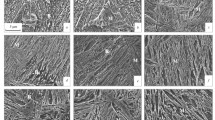Conclusions
-
1.
Manganese has much greater effect than nickel on the hardenability of low-carbon steels. Partial substitution of nickel by manganese helps form a martensitic structure at minimal cooling rates.
-
2.
The cooling rate from the austenite region has a small effect on the copper content in the solid solution due to the high solubility of this element in austenite, which has high stability.
-
3.
The dual heat treatment in the two-phase region (α+γ) helps increase the content of the reverted austenite in the structure of the steel, the maximum amount of which (60–80%) is observed after the first heating in the intercritical range.
Similar content being viewed by others
References
L. M. Kleiner, L. I. Kogan, and R. I. Éntin, "Properties of low-carbon alloy martensite", Fiz. Met. Metalloved.33, No. 4, 824–828 (1972).
R. I. Éntin, L. M. Kleiner, L. I. Kogan, et al., "Low-carbon martensitic steels", Izv. Akad. Nauk SSSR, Met., No. 3, 114–117 (1979).
L. M. Kleiner, L. I. Kogan, and R. I. Éntin, "Features of austenitic transformation in low-carbon steels", Fiz. Met. Metalloved.,41, No. 1, 118–122 (1976).
V. N. Nikitin, V. I. Kalmykov, and Yu. I. Rusinovich, "Phase composition and mechanical properties of the high-strength low-carbon steel 03G4N2MAF after tempering", Metalloved. Term. Obrab. Met., No. 7, 6–8 (1981).
B. M. Bronfin, V. G. Cheremnykh, A. A. Emel'yanov, et al., "Phase transformations and properties of low-carbon steels with high manganese and nickel contents," in: Heat Treatment and Metal Physics [in Russian], Sverdlovsk (1988), pp. 72–78.
I. Le May and L. M. Schetky, Copper in Iron and Steel, Wiley, New York (1982).
V. M. Schastlivtsev, I. L. Barmina, I. L. Yakovleva, et al., "Martensitic transformations in low-carbon steels", Fiz. Met. Metalloved.,55, No. 4, 724–732 (1983).
A. D. Wilson, E. G. Hamburg, and D. J. Colvin, "Properties and microstructures of copper precipitation aged plate steels", in: Microalloyed HSLA Steels: 1988 World Mater. Congress, Chicago (1988), pp. 259–275.
V. D. Sadovskii, "The transformation of austenite into martensite", in: Phase Transformations in Low-Carbon Alloys [in Russian], Mashgiz, Moscow (1950), pp. 65–71.
Yu. M. Kaletin, A. G. Ryzhkov, and A. Yu. Kaletin, "Alloying and heat treatment of steels with the bainitic structure", Metalloved. Term. Obrab. Met., No. 10, 13–17 (1987).
B. M. Bronfin, V. V. Ovchinnikov, and I. Yu. Pyshmintsev, "Phase transformations and the composition of reverted austenite in a low-carbon steel alloyed with manganese and nickel", Fiz. Met. Metalloved.66, No. 3, 571–577 (1988).
Additional information
Ural Polytechnic Institute. Translated from Metallovedenie i Termicheskaya Obrabotka Metallov, No. 4, pp. 2–4, April, 1993.
Rights and permissions
About this article
Cite this article
Bronfin, B.M., Pyshmintsev, I.Y. & Kalmykov, V.I. Phase transformations and the structure of high-strength low-carbon steels. Met Sci Heat Treat 35, 187–191 (1993). https://doi.org/10.1007/BF00775134
Issue Date:
DOI: https://doi.org/10.1007/BF00775134



